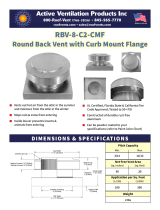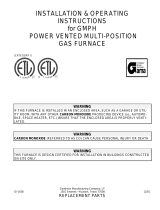
9
CIRCULATING AIR REQUIREMENTS
WARNING:
Do not allow combustion products to enter the
circulating air supply. Failure to prevent the
circulation of combustion products into the living
space can create potentially hazardous conditions
including carbon monoxide poisoning that could
result in personal injury or death.
All return ductwork must be secured to the
furnace with sheet metal screws. For installations
in confined spaces, all return ductwork must be
adequately sealed. When return air is provided
through the bottom of the furnace, the joint between
the furnace and the return air plenum must be air
tight.
The surface that the furnace is mounted on must
provide sound physical support of the furnace with
no gaps, cracks or sagging between the furnace
and the floor or platform.
Return air and circulating air ductwork must
not be connected to any other heat producing
device such as a fireplace insert, stove, etc. This
may result in fire, explosion, carbon monoxide
poisoning, personal injury, or property damage.
Plenums & Air Ducts
• Plenums and air ducts must be installed in accordance with
the Standard for the Installation of Air Conditioning and
Ventilating Systems (NFPA No. 90A) or the Standard for
the Installation of Warm Air Heating and Air Conditioning
Systems (NFPA No. 90B).
• Table 3, (page 21), Table 4, (page 22), & Table 5, (page
23) contains the maximum airflow and temperature rise
data for each furnace input rate. If the maximum airflow is
1,600 CFM or more, it is recommended that two openings
be used for return air on upflow furnaces.
• It is recommended that the outlet duct contain a removable
access panel. The opening should be accessible when the
furnace is installed in service and shall be of a size that
smoke or reflected light may be observed inside the casing
to indicate the presence of leaks in the heat exchanger.
The cover for the opening shall be attached in such a
manner as to prevent leaks.
• If outside air is used as return air to the furnace for
ventilation or to improve indoor air quality, the system must
be designed so that the return air is not less than 60° F
(15° C) during operation. If a combination of indoor and
outdoor air is used, the ducts and damper system must
be designed so that the return air supply to the furnace is
equal to the return air supply under normal, indoor return
air applications.
• When a cooling system is installed which uses the furnace
blower to provide airflow over the indoor coil, the coil must
be installed downstream (on the outlet side) of the furnace
or in parallel with the furnace.
• If a cooling system is installed in parallel with the furnace, a
damper must be installed to prevent chilled air from entering
the furnace and condensing on the heat exchanger. If a
manually operated damper is installed, it must be designed
so that operation of the furnace is prevented when the
damper is in the cooling position and operation of the
cooling system is prevented when the damper is in the
heating position.
• Seal all connections and joints with industrial grade sealing
tape or liquid sealant. Requirements for sealing ductwork
vary from region to region. Consult with local codes for
requirements specific to your area.
Return Air Connections
• In applications where the supply ducts carry heated air to
areas outside the space where the furnace is installed,
the return air must be delivered to the furnace by duct(s)
secured to the furnace casing, running full size and without
interruption. Do not use the back of the furnace for
return air.
• Position the furnace with the return air ductwork ensuring
even alignment of furnace (or coil casing) air opening and
return air duct. NOTE: The ductwork must have an opening
equal to that of the return air opening of the furnace (or coil
casing). See Figure 16, (page 18) for return air opening
size.
Upflow & Horizontal Furnaces
• The return air ductwork may be connected to the left side,
right side, or bottom of the furnace. NOTE: If using only
the left or right side of the furnace for return air, the bottom
panel (Figure 16) must not be removed from the bottom
of the furnace, except for airflows 1,600 CFM or higher.
WARNING:
The bottom panel of the furnace must be in place
when the furnace is installed with side return air
ducts. Removal of all or part of the base could
cause circulation of combustible products into
the living space and create potentially hazardous
conditions, including carbon monoxide poisoning
that could result in personal injury or death.
• Side Return Installations: To attach the return air duct
to the left or right side of the furnace, punch out the 4
knockouts from the side of the furnace (Figure 16). Using
sharp metal cutters, cut an opening between all 4 knockouts
to expose the blower assembly. Position the return air duct
over the opening and secure to the side with sheet metal
screws.
• Bottom Return Installations: If using the bottom of the
furnace for return air, the bottom panel (Figure 16) must
be removed from the bottom of the furnace. See page
11 for removal instructions. Position the furnace over
the return air duct and secure together with sheet metal
screws. Make sure the screws penetrate the duct and
furnace casing.
Supply Air Connections
• The supply air must be delivered to the heated space by
duct(s) secured to the furnace or coil box casing, running
full size and without interruption.
• To attach the supply air duct to upflow & horizontal furnaces,
bend the flanges on the furnace upward 90° with wide
duct pliers. See Figure 16, (page 18) for furnace flange
locations. NOTE: If system installation includes AC coil






















